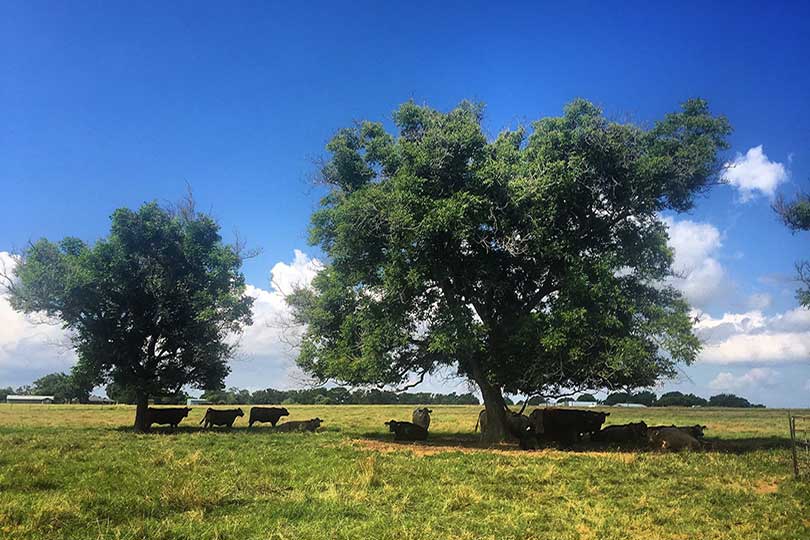By Adam Russell
Texas A&M AgriLife Communications
Texas cattle and livestock are starting to feel the heat as summer temperatures climb past 100 degrees.
Dr. Joe Paschal, Texas A&M AgriLife Extension Service livestock specialist in Corpus Christi, said livestock are entering a “summer slump,” where weight gains and body condition scores can dip as animals avoid the heat.
Paschal said temperatures are reaching their typical triple-digit mark with regularity, which along with high humidity, has animals seeking shade and cooling themselves in available water.
Animals are spending more time trying to stay cooler and less time eating, he said. Additionally, the forage they are consuming is lower quality.
“Heat stress lowers productivity,” he said. “It’s hot, and livestock, especially cattle, bunch up under shade trees or in water to stay cool, so they’re eating less. At the same time, grasses are turning brown. We’ve got plenty of it, but the quality is going down. It’s a double-edged sword.”
Paschal said most cattle in South and Central Texas experienced better-than-average conditions as spring rains brought plenty of moisture to ranges and pastures and water for consumption. But maintaining good body condition would depend on cattle’s ability to adapt to the heat as well as forage receiving timely rains to feed new, protein-rich growth on ranges and pastures.
Dr. Bruce Carpenter, AgriLife Extension livestock specialist in College Station, said most ranges and pastures were faring well because of spring rains. It’s been hot and humid, and temperatures have topped 100 degrees a few times since late June but nothing out of the ordinary.
Carpenter said intermittent tanks were still holding water for cattle but most of the area utilizes wells to water herds.
“It’s been a pretty good year so far,” he said. “Most areas are green and better than average, especially for this time of year.”
Carpenter said Angus cattle, other dark-hided breeds and cattle breeds not adapted to hotter conditions would likely have more difficulty.
“That’s most of the battle, having cattle that fit the environment,” he said. “You’ll see problems in feedlots when you have cattle that aren’t used to cold or hot conditions they might be moved to. It works both ways.”
Dr. Ted McCollum, AgriLife Extension beef cattle specialist in Amarillo, said there had been reports of heat stress and some animal deaths in feedlots due to higher-than-normal temperatures in the Southern Plains and Panhandle regions, but those instances had not been widespread.
“We’ve had unusual heat–temperatures over 100 for several days–and set some records for daily highs,” he said. “It’s normal to see 100 degrees a few times but not a run of days like we’ve had.”
Nighttime temperatures are not dropping to usual lows either, he added. Temperatures typically drop into the high 60s to low 70s at night but have remained above these, with some in the low 80 degrees, which doesn’t provide as much opportunity for cattle to unload heat from their body.
McCollum said parts of those regions are also behind on rainfall, and forages are not performing as well as in other parts of the state. Additionally, there has been little supplemental feeding so far.
The forecast for the next three months shows equal chances of dry and wet weather, McCollum said. The outlook is normal for the season and producers are hoping for cooler temperatures and timely precipitation.

